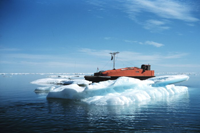
In light of the recent reductions of Arctic sea ice, the volume of ship traffic in the Arctic Ocean offsite link will almost certainly increase over the coming century. This anticipated increase in shipping may have serious environmental consequences because much of the Arctic marine environment is a relatively pristine area, yet highly vulnerable to disturbance and pollution due to the changes in the Arctic sea ice and the generally sensitive nature of the Arctic marine ecosystem. Potential impacts from shipping include: the release of oil through accidental or illegal discharge, ship strikes on marine mammals, the introduction of alien species, disruption of migratory patterns of marine mammals, increased anthropogenic noise and increased atmospheric emissions. The Arctic Council recently released the Arctic Marine Shipping Assessment offsite link which examines many of these issues and suggests possible measures that may be used to address them. The 2009 U.S. National Security Directive on Arctic Region Policy outlines the U.S. position on these issues.
The International Maritime Organization (IMO) offsite link is the primary international body that regulates international shipping. The Arctic Council offsite link, primarily through the Protection of the Arctic Marine Environment (PAME) offsite link working group has become more active in attempting to anticipate and monitor the impacts of shipping on the Arctic marine environment. Within the overarching framework of the 1982 UN Law of the Sea Convention (LOSC), these bodies have adopted guidelines including:
- LOSC Article 234 Ice-Covered Areas offsite link
- IMO Guidelines for Ships Operating in Arctic Ice-Covered Waters
- IMO Enhanced Contingency Planning Guidance for Passenger Ships Operating in Areas Remote from Search and Rescue (SAR) Facilities offsite link (May 31, 2006)
- IMO Guidelines on Voyage Planning for Passenger Ships Operating in Remote Areas (Jan. 3, 2008)
- IMO Guidelines for Voyage Planning offsite link
- IMO Guide for Cold Water Survival offsite link (May 31, 2006)
- IMO Guidelines for Ships Operating in Polar Waters offsite link(Jan. 18, 2010)
- IMO Guidelines for Preparing Plans For Co-Operation Between Search and Rescue Services and Passenger Ships (July 10, 2003)
- Arctic Council’s Arctic Offshore Oil and Gas Guidelines offsite link (2009)
- Arctic Environmental Protection Strategy (AEPS) offsite link
In addition, many broader international agreements also apply to Arctic shipping, including the following IMO conventions (Summaries):
- The London Dumping Convention offsite link(08/30/75) (document download) and its 1996 Protocol (03/24/06) (document download)
- MARPOL offsite link and (document download)
- Safety of Life at Sea (SOLAS) offsite link
- The Convention on the International Regulations for Preventing Collisions at Sea offsite link
- International Convention on Oil Spill Preparedness Response and Cooperation offsite link
- International Convention on Load Lines and Protocol offsite link
- International Convention on Standard of Training, Certification and Watchkeeping for Seafarers offsite link
- International Convention on the Control of Harmful Anti-fouling Systems on Ships offsite link and document download
- International Convention for the Control and Management of Ships' Ballast Water and Sediments offsite link and document download.
- Association of Classification Societies (IACS) Requirements for Polar Ships offsite link International Requirements for Ships Operating in Polar Waters. offsite link (download)


